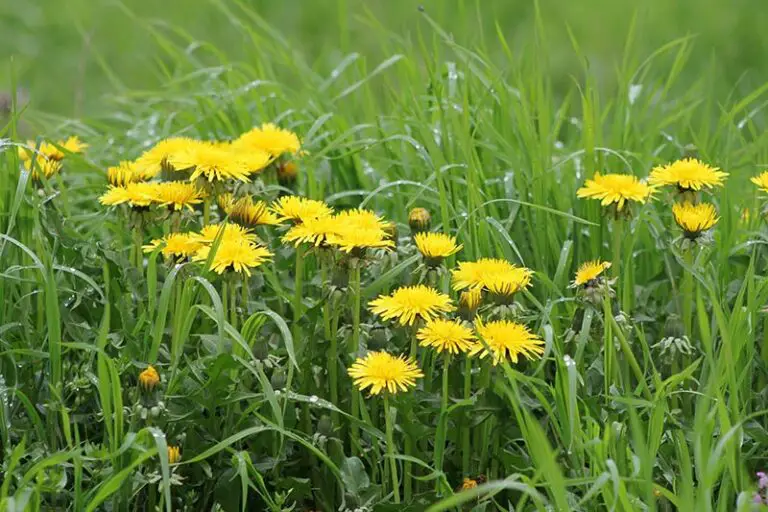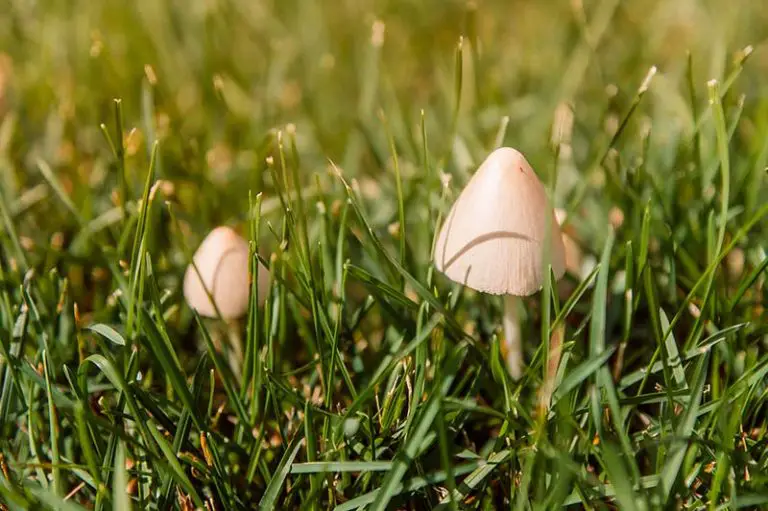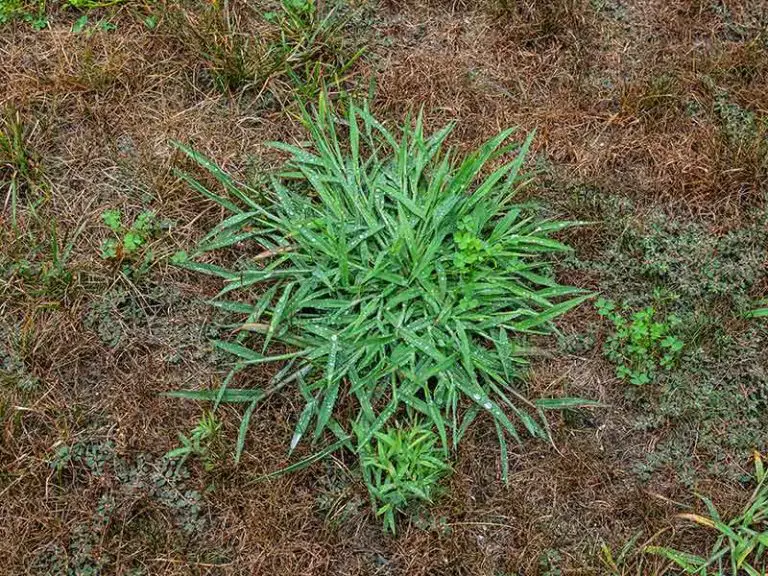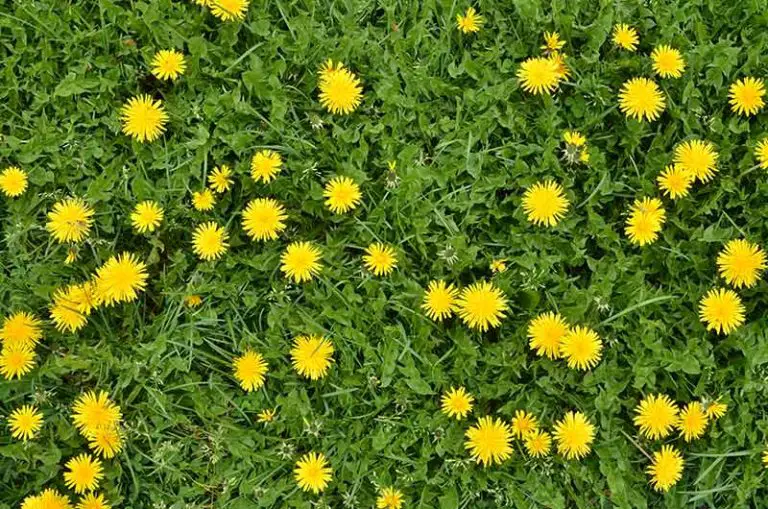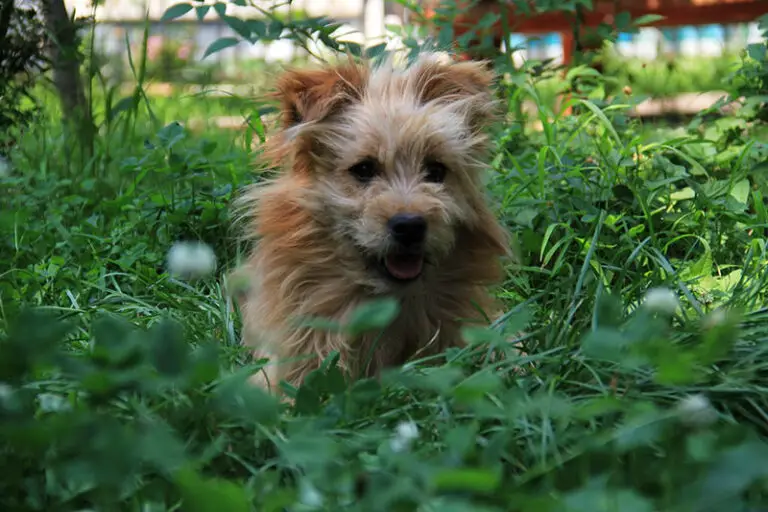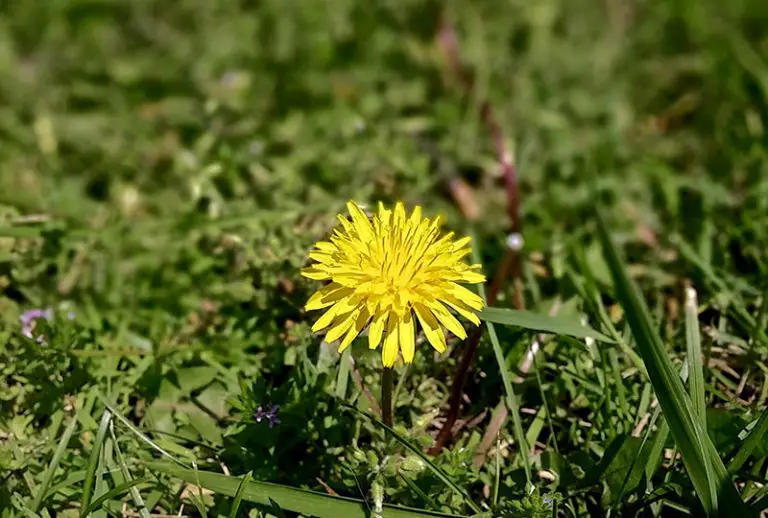How to Get Rid of Bindweed
Often mistaken for its cousin morning glory, bindweed is an invasive perennial weed that takes over yards with its creeping, climbing vines. Due to its extensive root system, bindweed is notoriously difficult to control. However, there are some measures you can take to get rid of bindweed from your yard for good.
Methods to get rid of bindweed naturally include digging the weed up by hand, cutting the weed down, or smothering the weed with fabric, plastic, or a thick mulch. Chemical methods of bindweed control involve spraying the weed with a non-selective weed killer.
Read on to learn how to identify the type of bindweed you’re dealing with, followed by step-by-step guides on the natural and chemical removal of this weed.
What is Bindweed?
Bindweed is a perennial vine, being in the same family as morning glory. It is an invasive weed that grows aggressively throughout a yard or planting area, choking out nearby plants.
As bindweed is a vine, it grows creeping across soil, or climbing up shrubs and fences and around structures like poles and trees. The weed’s spiraling stems grow along the ground until they make contact with other plants and structures. Once they make contact with something upright, they climb up it by wrapping themselves around it.
To reproduce, bindweed spreads through soil using both seeds and an extensive underground root system. Some bindweed roots can grow as deep as 20 feet or more, while the seeds may remain viable in the soil for up to 60 years. It is due to these qualities that bindweed control can be relatively challenging and laborious.
Bindweed Identification
There are two main variations of bindweed in the US: field bindweed and hedge bindweed. Both variations are perennial vines with extensive root systems, but they vary slightly in appearance and behavior. As a brief differentiation between the two, field bindweed tends to creep along the ground, while hedge bindweed tends to climb.
We have provided more information below to help you identify what type of bindweed you’re dealing with in your yard.
Field Bindweed
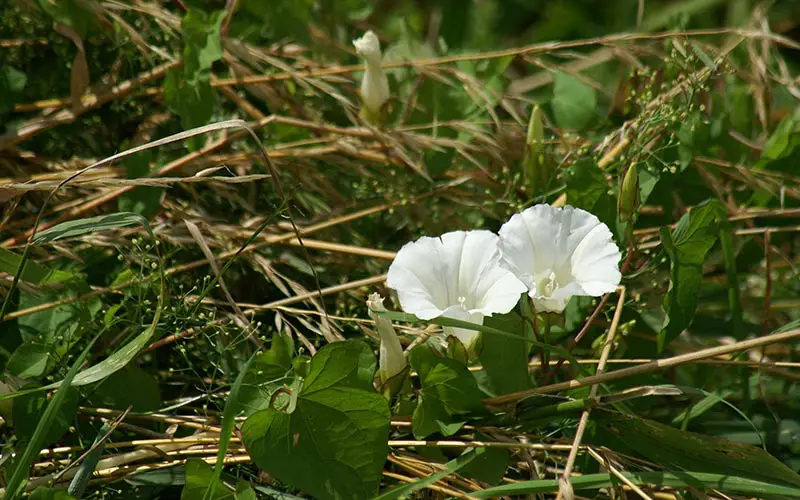
Where Field Bindweed Grows
Field bindweed grows throughout the US, being found among agricultural and horticultural crops, ornamental landscapes, and in the turf on lawns or gardens. It tends to grow by creeping along the ground, rather than climbing like hedge bindweed. Generally, field bindweed thrives in areas where it has full access to the sun.
Field Bindweed Seedlings & Sprouts
Field bindweed reproduces itself using seeds and rhizomes. The seeds may remain viable in the soil for more than 50 years, germinating during the spring and early summer. Also during the early spring, the bindweed seedlings produce shoots from their rhizomes.
Young field bindweed seedlings grow smooth, dark green cotyledons, which are the seed-containing leaves that appear first after germination. The cotyledons are relatively large and appear square to kidney-shaped with long petioles, smooth edges, and whitish veins. They typically have a slight indentation at the top of the leaf.
The first leaves of young field bindweed seedlings are bell-shaped and sit at the end of petioles. They have lobes at their base and measure to be about ½ to 1 ½ inches long.
Field Bindweed Mature Plants
The stems of field bindweed plants are either completely smooth or slightly hairy, reaching 2 to 7 feet in length. These stems allow the weed to grow creeping along the ground or twining up other vegetation or upright structures.
Mature field bindweed plants have arrowhead-shaped leaves that point away from their petioles. The leaves typically grow to be 1 ½ to 2 ½ inches long, measuring smaller than hedge bindweed leaves.
The rhizomes of the mature field bindweed plant are extensive, potentially growing up to 30 feet deep into the soil.
Field Bindweed Flowers & Seeds
Field bindweed plants produce flowers between June and September. The plants form 1 to 2 flowers at the points where the leaves meet the stem, also known as the leaf axil. Each flower has two small, leafy bracts at its base.
The flowers of field bindweed are usually white, but occasionally they may also have a pinkish tinge. They are about 1 inch wide and shaped a funnel, forming a trumpet-like flower. These flowers tend to be smaller in size than those produced by hedge bindweed.
The fruits of field bindweed are rounded oval capsules that contain 4 seeds each. The seeds measure about 1/10 of an inch long and are dull gray to brown or black in color. On one side the seeds are round, and on the other they are flat.
Hedge Bindweed
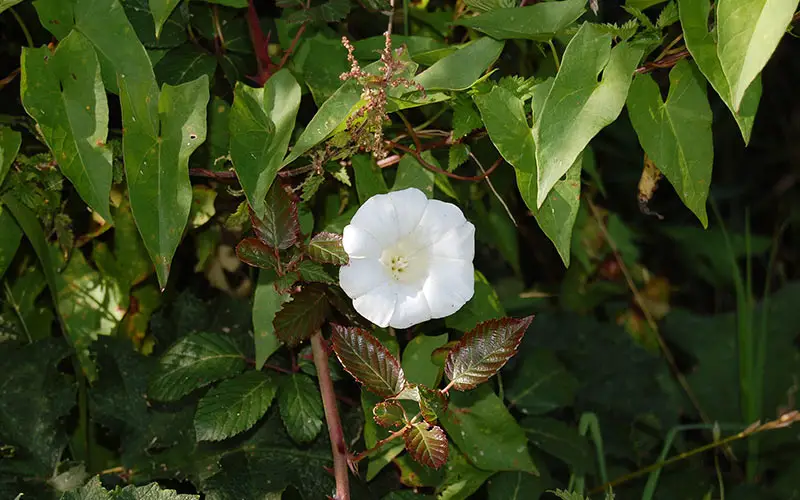
Where Hedge Bindweed Grows
Hedge bindweed tends to grow by climbing, rather than spreading along the ground like field bindweed. It is typically found climbing up shrubs, fences, and throughout open fields or along roadsides. Hedge bindweed prefers rich, moist soils in lowland areas. It thrives in partial shade or full sunlight.
Hedge Bindweed Seedlings & Sprouts
Hedge bindweed spreads using seeds and rhizomes. The seeds germinate during the spring and early summer, with shoots from the weeds’ rhizomes emerging in the early spring.
The cotyledons of young hedge bindweed seedlings are smooth, square-shaped, and have an indentation at the leaf tip. The cotyledons sit at the end of long petioles. Take note that if the plant has formed from a rhizome, it will lack cotyledon leaves.
Young hedge bindweed leaves vary in shape, being heart-shaped, triangular, or sharply lobed at the leaves’ base. They also sit at the end of long petioles.
Hedge Bindweed Mature Plants
The stems of mature hedge bindweed plants are either smooth or slightly hairy, reaching between 3 and 10 feet long. As these stems are smooth and the plant lacks tendrils, it winds itself around other plants and upright structures for support.
The leaves of mature hedge bindweed plants are alternate and oblong, measuring between 2 to 5 inches. They are typically shaped like an arrowhead with a sharply pointed tip, with long petioles and angled lobes at the leaf base. They are larger in size than field bindweed leaves.
While the rhizomes of hedge bindweed are extensive and fleshy, they are relatively shallow, only measuring to a depth of about 10 to 12 inches.
Hedge Bindweed Flowers & Seeds
Hedge bindweed plants produce flowers from July until August, only forming one single flower at the axil between the stem and the leaf. The stalks of the flowers are about 2 to 6 inches long.
The flowers of hedge bindweed are usually white, but may also be pink colored. They are funnel-shaped to form a trumpet-like flower. The flowers of hedge bindweed are slightly larger than field bindweed, measuring about 1 ½ inches wide.
The fruits of hedge bindweed are rounded capsules that contain between 2 and 4 seeds each. The seeds are dull gray to brown or black in color and measure 1/10 of an inch in length. They have one flattened side and one rounded.
Bindweed vs Morning Glory
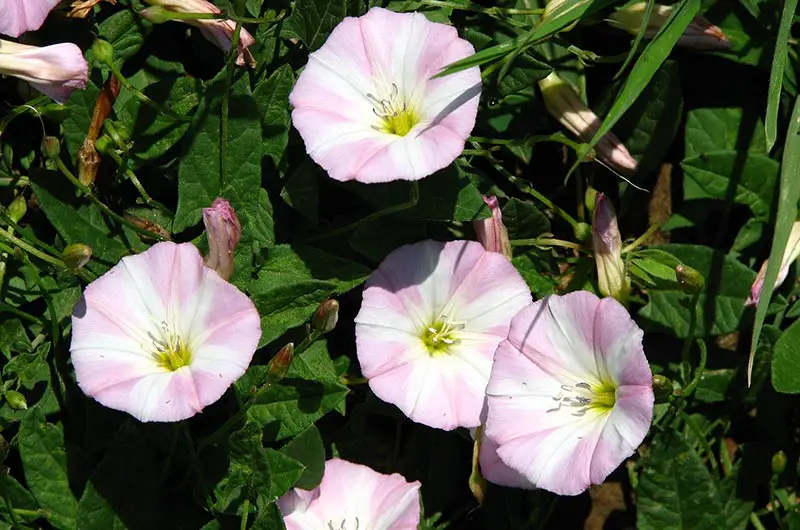
Bindweed
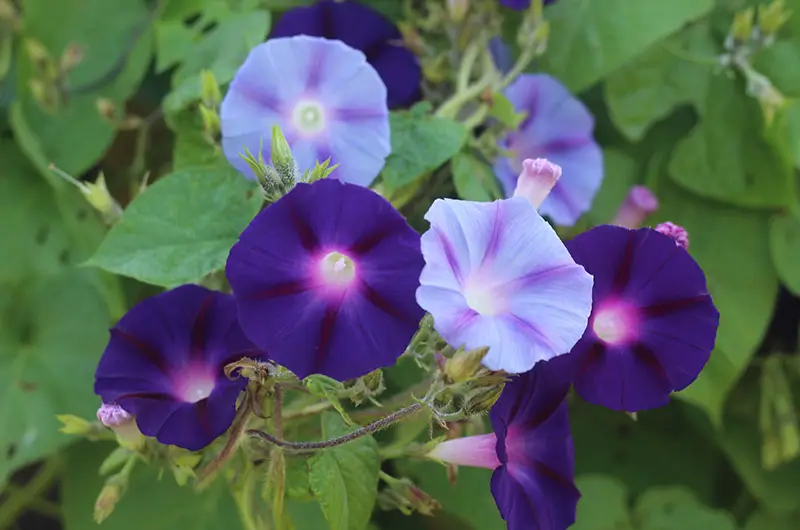
Morning Glory
While the two plants are very closely related and often confused, bindweed and morning glory are not the same. They are both vines, however, bindweed is a perennial weed while morning glory is an annual plant. This means that morning glory dies off in the cooler months before reseeding itself the next year, but bindweed plants are able to survive throughout the year.
In appearance, the two plants are extremely similar. They both have distinctive trumpet-shaped flowers; the flowers of bindweed are white to light pink and typically smaller than morning glory flowers, while morning glory flowers may be other shades colors of red, blue, or purple. The leaves of bindweed plants are also slightly smaller and narrower than morning glory leaves.
How to Get Rid of Bindweed Naturally
Before you reach straight for the chemicals, consider these methods to get rid of bindweed naturally.
Dig Up Bindweed
It’s possible to get rid of bindweed naturally by digging up the plants and their root systems by hand. Take note that with this method, it’s essential to get rid of as much of the root system as possible. Bindweed plants have extensive roots that spread quickly through rhizomes and will be able to regenerate themselves if any fragments of these roots are left in the soil. For this reason, hand removal is only suitable for smaller infestations of bindweed.
1. Wait Until Fall or Winter
While this step isn’t necessary, it’s highly recommended to wait until fall or winter to remove the bindweed by hand. At this time of year, the bindweed plants will be dormant and the majority of the growth from the previous season will have died off, making the removal job a lot easier.
This is particularly helpful if the bindweed has entwined itself around nearby perennial plants in your garden; while your plants are dormant, you can maneuver them and untangle them from the bindweed before replanting them.
2. Choose a Suitable Digging Tool
The best tool to use for this job is a garden fork. You could use a spade, however, this will likely break up the roots in the soil during removal. You want to avoid breaking up the roots at all costs as this will only worsen the bindweed problem.
3. Moisten Soil
Skip this step if it has rained recently or conditions are already damp. If not, add enough water to the area to moisten the soil. This will ease the removal process, helping you to pull up as much of the bindweed roots as possible without breaking them up.
4. Loosen Soil
Use your garden fork to gently turn over and loosen the soil underneath the bindweed plants and expose the weeds’ roots. Remember that bindweed roots can grow as deep as 10 feet into the soil, so make sure you loosen the soil to a sufficient depth depending on the maturity of your weeds.
5. Remove Bindweed and Root Systems
Once you have loosened the soil around the bindweed, pull up the plants and as much of their root systems as possible. Dispose of the plants and roots by throwing them in the trash. Avoid placing them into your compost, as this may end up reintroducing the weed to your yard.
6. Repeat As Necessary
Due to the nearly impossible challenge of removing all of the weeds’ roots, it’s likely that you will have to repeat this method a few times to get rid of the bindweed completely. Repeat the previous steps as necessary until the bindweed stops returning.
Cut Bindweed Down
You can get rid of bindweed over time by continuously cutting the weeds down. This method is a good alternative if you’re unable to dig around in the planting area without harming nearby plants. It’s also more suitable in the case that you’re dealing with established weeds during the summer months. The only drawback to this method is that it must be repeated continuously throughout the growing season for full results.
1. Choose a Suitable Cutting Tool
Gather an appropriate tool, such as scissors, pruners, or garden shears.
2. Cut Bindweed Stems
Taking your chosen tool, cut off the bindweed vines as close to the soil level as possible. Dispose of the plant matter in the trash. Do not place the bindweed vines on your compost, as this may reintroduce the weed back into your yard.
3. Repeat Weekly Throughout Season
Repeat this process every week, cutting off new growth as it appears. Removing the foliage causes the bindweed to use up the energy in its roots, which eventually kills the plant entirely. It’s essential to repeat this process continuously in order to get rid of the bindweed for good.
Smother Bindweed with Mulch
Smothering the plants with mulch is another method you can use to get rid of bindweed without digging into your planting area. Like many other weeds, bindweed requires access to sunlight to photosynthesize and grow. You can kill bindweed plants by smothering them, cutting off their access to these essential elements. This method is highly effective, however, it will take about a year to fully get rid of the bindweed.
1. Choose an Appropriate Mulch
First, you need to choose an appropriate material that will completely block the weeds’ access to sunlight. We suggest using weed control fabric, black polythene, or sections of an old carpet. You could even use cardboard covered in a layer of organic mulch.
2. Dig Up Wanted Plants
If there are plants in the affected area that you don’t wish to smother, you will need to dig them up before laying your material. This method will kill weeds along with anything else growing beneath the mulch.
3. Lay Mulch Over Affected Area
Taking your smothering material of choice, lay it over the planting area. If using fabric or plastic, weigh down the edges of the material using heavy objects like large rocks. Make sure that all light is blocked from reaching beneath the material.
4. Wait at Least a Year
Leave the mulch in place for at least a year, ideally leaving it for as long as five years. This will eventually smother the bindweed plants and kill them off completely. Keep monitoring the area around the edges of the mulch for signs of bindweed growth.
How to Get Rid of Bindweed With Chemicals
It’s best to avoid using chemicals in your yard due to the harm they can cause to the local environment. However, sometimes chemical control is necessary for severe infestations of bindweed, or for those that need a quick-acting method of bindweed control. In these cases, you can use a commercial herbicide to get rid of bindweed fast.
1. Choose an Appropriate Herbicide
There are no selective herbicides on the market that exclusively kill bindweed; you will need to purchase a non-selective product containing the ingredient glyphosate.
2. Isolate Bindweed
As non-selective weed killers kill any and every plant on contact, you will need to isolate the bindweed from other plants in the affected area. The most effective way to do this is to train the vines along bamboo canes by strategically placing them near the bindweed plants in the spring. If this isn’t possible, carefully untangle the bindweed from other nearby plants and lay it on a sheet of cardboard or plastic instead.
3. Put on Protective Clothing
Before applying the herbicide, put on full protective clothing to avoid coming into contact with the harmful chemicals. Wear long-sleeved clothing, as well as rubber gloves, work boots, and safety glasses. Also, read the label of your chosen product carefully for exact safety and application instructions.
4. Spray Bindweed
Using your non-selective weed killer, spray the isolated bindweed plants. This weed killer will kill anything it touches, so you need to be extra careful with its application. Spray the leaves of the plant liberally, then spray the area where the roots come up from the soil.
5. Repeat Method 2 to 3 Times
Repeat the previous steps 2 to 3 times throughout the growing season to completely get rid of the bindweed.
How to Dispose of Bindweed
To properly dispose of bindweed, place it in your garden waste bin or take it to your local recycling center. You should never place bindweed plant matter, particularly its roots, onto your compost pile or in your compost bin. The roots will survive and will inevitably reintroduce the bindweed into your yard when you go to spread the compost.
With that said, it’s still possible to compost bindweed. Instead of combining it with your normal compost, place it in a robust black plastic sack. Fold the top of the bag over and leave it to decompose for at least a year. At this point, it will be safe to use as compost in your yard without reinfesting your soil.
How to Prevent Bindweed From Returning
There are a few cultural measures you can take to prevent bindweed from making its way back into your yard.
Check Soil, Seed, Hay, and Animal Feed
Avoid reintroducing bindweed to your yard by being cautious with any soil, seed, straw, or animal feed you use around your home. Check that the ingredients of these products don’t contain bindweed seeds, buds, or root fragments before using them.
Monitor Soil and Pull Weeds By Hand Weekly
Prevent bindweed from taking over by keeping an eye on your lawn or garden soil for signs of early growth. Pull the weeds up as soon as you see them in order to prevent them from establishing and multiplying. The younger the shoot, the easier it is to pull the plants, so do this as soon as you notice any amount of bindweed growth. Make it your routine to monitor the soil and pull up any new growth every week to keep bindweed at bay.
Keep Soil Healthy
Keep your soil healthy to stave off the growth of bindweed in your lawn or garden. Bindweed thrives in soils that are imbalanced, when the pH level is wrong, and/or the soil has excessive amounts of magnesium and potassium present. Test your soil regularly to find out its pH and nutrient levels, and adjust the soil with amendments as necessary. This may include fertilizing your lawn with organic fertilizer, materials containing calcium or phosphorus, or pH-adjusting materials such as lime or sulfur.
Create a Physical Barrier Around Yard
You can prevent bindweed from creeping in from other yards by putting up a physical barrier around your own yard. Take large pavers or sheets of hard plastic or metal and insert them 18 to 20 inches deep into the ground around the perimeter of your yard at the points where bindweed would be able to get in.

